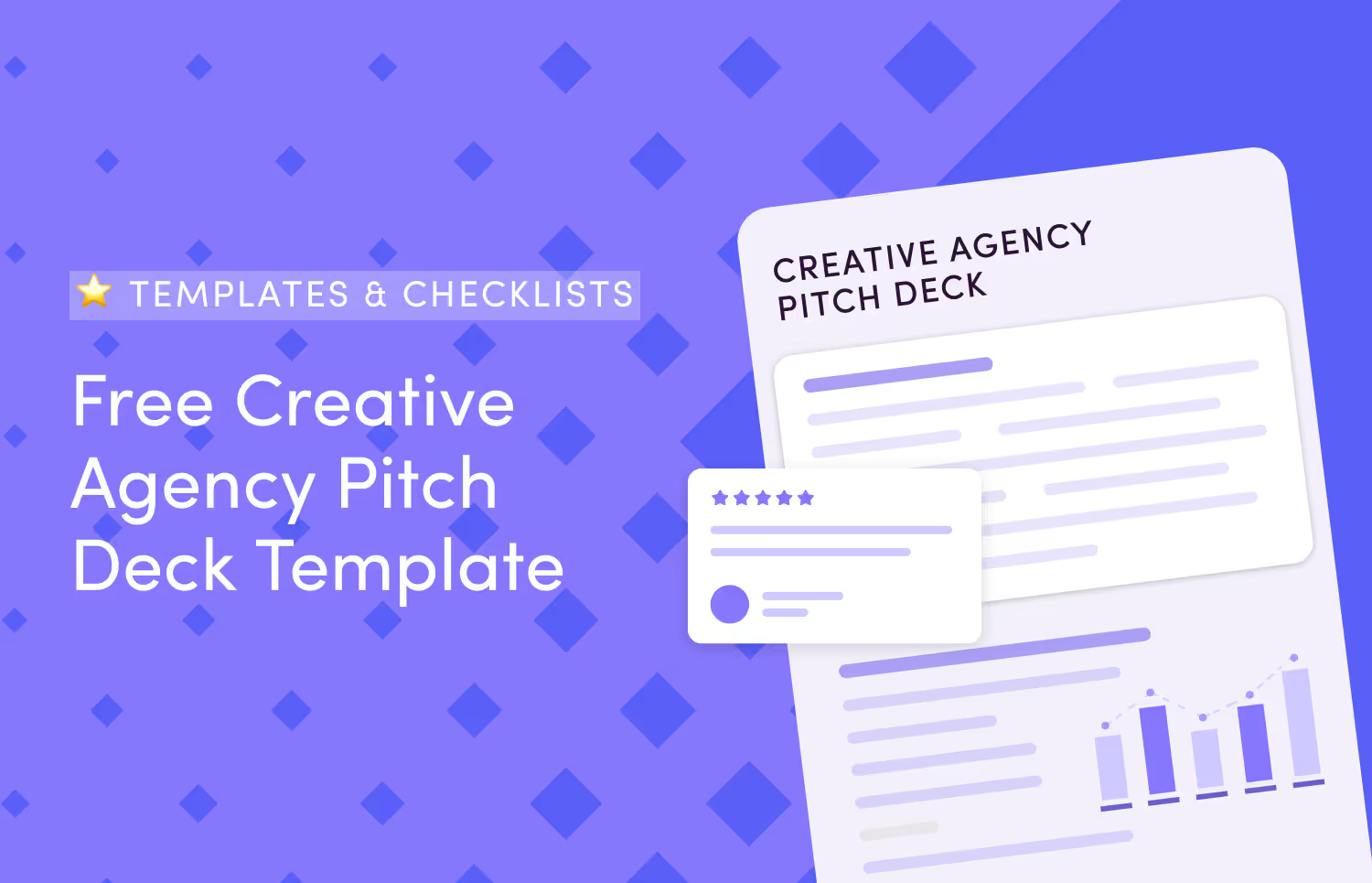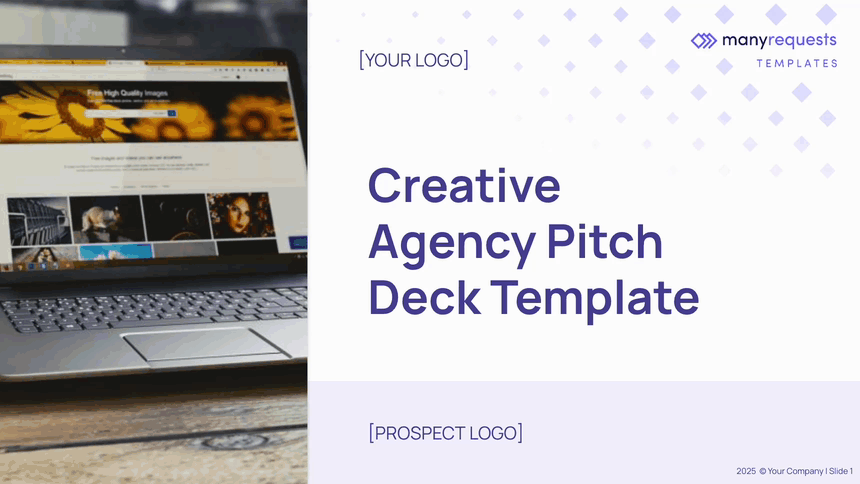

Getting your dream client shouldn't feel like a guessing game. Too many creative agencies enter meetings with presentations that fail to capture what clients truly want. A great creative agency pitch deck is your most effective tool for turning uncertain prospects into excited clients who are ready to hire you.
Your pitch deck needs to demonstrate results that clients can see and measure. This guide will show you how to build presentations that actually win new business, along with a free template in Google Slides format you can use right away.
Walk into most agency pitches and you'll see the same mistake over and over. Rather than focusing on business results, agencies are showcasing their best work. They act like clients hire them because their designs won some fancy award, but clients don't care about your awards. They care about solving problems that hurt their business.
Most creative agencies fall into what we call the portfolio trap. They fill their presentations with beautiful images and clever concepts, but they never connect those pretty pictures to actual business outcomes.
A client doesn't wake up thinking "I need better fonts." They wake up thinking "I need more customers," or "I need to beat my competition," or "I need to stop losing money."
Your creative agency pitch deck needs to link your creative work and their business results. Every single slide should answer one simple question: "How does this help them make more money, save time, or reduce risk?"
Smart agencies employ a straightforward formula that consistently yields results. First, you identify their specific business challenge. Then you present your creative approach to solving it. Finally, you prove the financial impact with real numbers from past projects.
Think about it this way.
When a CEO sees a beautiful website design, they're not thinking "wow, that's pretty." They're thinking, "Will this help us sell more?" Your job is to connect those dots for them before they have to ask.
The agencies that win the most business understand this connection. They don't just show what they made. They show what happened after they made it. More sales, better brand recognition, higher conversion rates, and increased customer loyalty. These are the results that matter.
Forget those 30-slide presentations that put everyone to sleep. The best agency pitch decks follow a simple 8-slide structure that keeps prospects engaged from start to finish.
Here's the winning formula:
Agency sales decks work entirely differently from those startup presentations you see online. While startups discuss future potential and how big their market might become, agencies need to prove they can deliver immediate value with real examples from past work.
Startups spend time explaining their product features and business models. Still, agencies focus on showcasing case studies with precise results and walking clients through their proven process for achieving results. When startups present timelines, they typically project future growth over several years. In contrast, agencies need to provide specific implementation details and realistic deadlines for completing the actual work their clients require.
The Problem-Solution-Proof Formula
Every excellent design agency pitch follows the same basic flow that matches how business executives naturally make decisions.
This formula is so effective because it follows the natural way people think when making business decisions– they identify problems, look for solutions, and need proof before moving forward.

Now let's dig into exactly what belongs on each slide of your agency pitch deck. These aren't just suggestions. This is the proven structure that wins new business.
Your opening slide needs to grab attention immediately. Skip the "welcome to our presentation" talk and jump straight into an insight about their industry that connects to their biggest challenge. Find a shocking statistic about their industry, then ask a direct question that makes them think.
For example: "73% of buyers say they'd pay more for better customer experience. Is your current branding helping or hurting that perception?"
This works because it shows you understand their world and prompts them to think about their challenges instead of your portfolio. Your client pitch presentation should always start with their problems, not your solutions. Don't start with your company history, mission statement, or "about us" timeline– none of that grabs attention.
Build credibility quickly using the SCAR method: specialization, credibility, approach, and relevance.
Show what makes you different from other agencies, display three to five logos of recognizable clients, explain your unique problem-solving process, and connect everything back to their specific situation.
Keep this short– include your founding date and team size if it builds confidence, but skip the long company stories and awards that don't relate to business results.
This slide proves you've done your homework about their specific situation.
Show industry challenges backed by real data, point out competitive gaps you've identified, and compare their current performance to industry standards. Make it specific to them - don't just share general trends, but show how those trends affect their business specifically and connect problems to lost revenue or missed opportunities.
Present case studies using the STAR method: Situation (describe a client with a similar challenge), Task (what needed to be accomplished), Action (your creative solution and why you made those choices), and Results (specific metrics that prove it worked).
For example: "Local restaurant chain was losing customers to delivery apps. We redesigned their mobile ordering and created a loyalty campaign. Direct orders increased 47% in three months."
Make sure both case studies relate directly to your prospect's situation.
Include 2-3 brief client testimonials that address common concerns prospects have about working with agencies.
Focus on testimonials that highlight reliability ("They delivered everything on time and within budget"), results ("Our sales increased 34% within two months"), and experience ("Their team made the entire process smooth and collaborative").
Keep testimonials short (1-2 sentences maximum) and include the client's name, title, and company when possible. This social proof bridges the gap between your proven case study results and your proposed solution, giving prospects confidence before they see your pricing.
Answer four critical questions:
Be specific about deliverables, connect everything back to their challenge, give realistic timelines with milestones, and define precisely how you'll prove success with particular metrics.
Present three investment options using a good, better, best structure with specific deliverables and timelines for each package. Make the next steps crystal clear– tell them exactly what you need to get started, provide a timeline for decisions, and create some urgency without being pushy.
Never end a pitch without clearly stating pricing and outlining obvious next steps.
You now have the complete framework for creating creative agency pitch decks that convert prospects into excited clients.
The difference between agencies that consistently win new business and those that struggle isn't about talent or creativity– every agency has that. The difference is having a systematic approach to presentations combined with the systems to deliver exceptional results once you win the work.
Winning the pitch is just the start. The real challenge is delivering on your promises without chaos. ManyRequests helps you manage projects, communicate with clients, and keep your team organized in one simple system. When you deliver smoothly, clients come back and refer others.
Ready to transform your agency's pitch process? Download our free pitch deck template for agencies to get started, then try ManyRequests free for 14 days to make sure you deliver what you promise.
Your pitch deck needs a strong hook that addresses the client's challenge, an "About Us" section that builds credibility, case studies with measurable results, your proposed solution tailored to their needs, transparent pricing, and clear next steps. Focus on their business outcomes rather than fancy graphics- building trust matters more than impressing them with creativity.
Pitch decks, especially for agencies, should ideally be concise– ranging from 8 to 15 slides, depending on the complexity of the offering. The focus should be on delivering a clear, straightforward story without overwhelming the audience with excessive details. The popular 10-20-30 rule suggests using 10 slides, allocating 20 minutes of presentation time, and using a 30-point font size for clarity and impact.
Using a template is highly recommended as it provides a consistent structure, design cohesiveness, and saves time. Templates can be customized to fit your brand style and content needs while ensuring professional visual quality and readability.